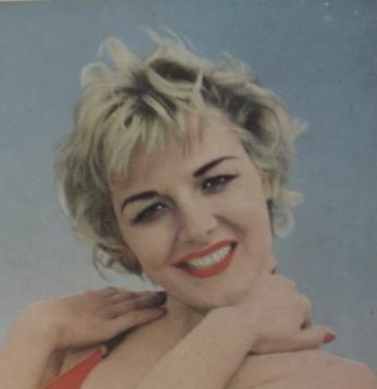Judy Walsh
Only the most dedicated moviegoers would know of Judy Walsh (1932-2006). She was an actress who had a brief chance at stardom, but faded too soon. She wasn't blonde, nor was she curvaceous. She was that are dark-haired actress who was given starring roles in black-and-white movies. The most interesting thing about her career is that she was a trained actress, but was discovered completely by chance. She was incredibly talented, and a profile on her is deserving.

Helen "Judy" Barclay Walsh was born on March 16, 1932 to James E. and Mary B. Walsh. Her parents divorced shortly afterwards, and she was raised by her mother and stepfather John S. Mason. She and her sister Mary spent their childhood in Big Bear Lake, where Judy won various pageants including
"Snow Princess of 1949". She was also a cheerleader. The family was prominent in their city, as their mother -in addition to having a housekeeper- founded the Women's Civic League, wrote columns for The Grizzly, and was a talented musician.
Judy graduated from Big Bear High School in 1949. An aspiring actress, she studied drama at Arizona State University. She started acting in walk-on roles in movies such as Take Care of My Little Girl (1951) and Aladdin and His Lamp (1952). She gained national attention when the Los Angeles Times published a story on her on August 5, 1951 titled "1951 Eyeful: Hollywood's Judy Walsh". She did some modeling between acting gigs.
She was signed to RKO Pictures by Howard Hughes in 1951
after a representative saw her walking in Palm Springs, and she was cast as Nah-Lin in The Half Breed (1952). A lot of pundits were surprised that her debut in a credited role was as an unglamorous Native-American housekeeper, but producers felt that her flawless tan and dark hair would fit the role. Producers would later warn her to avoid tanning so she could get mainstream roles. Although unconventional, it was a breakthrough role for Judy, and newspapers across the country praised her as the "Star of Tomorrow" and "Dish of the Year." At the height of her career, she fell in love with a film editor named David A. Schonleber. They married that year and had a son, Travis Eric Schonleber. As with most women in Hollywood, she retired from acting in lieu of motherhood.
Although she didn't regret marriage, Judy grew bored and restless. She regretted not capitalizing off of the success of her prior movies, and she wished that she accepted the starring role in Howard Hawks' The Big Sky (1952) that became a box-office success. She contacted RKO Pictures to see what her options were. They agreed to re-sign her, and they cast her -
ironically I'd add- in Second Chance (1954). It was a part more glamourous and fitting for a star. Judy and David divorced in 1954, while her sister Mary wed an actor named Douglas Fowley.
Judy and her son lived on 834 N. Fuller Avenue in Los Angeles.
She continued to accept walk-on roles to support herself and her son. She appeared in Cat-Women of the Moon (1953) before landing her greatest role of her career as Luora in the cult class Cannibal Attack (1954) alongside Johnny Weissmuller. Although it received good reviews, it wasn't a good experience for Judy. She didn't like the toxicity of Hollywood, and gave up acting entirely. She also felt that she had other talents that she wanted to use, so she delved into entrepreneurship. She moved to Temecula and founded The Grange -an apparel store- in 1968. Months later, she married a winery owner named John Moramarco. They had a son named Anthony, and Judy finally felt content with her life. She no longer missed acting or fame.
Judy moved to Honolulu, Hawaii near her son. She returned to Temecula and was active in The Green Valley Church of Religious Science and various animal rights groups. She died on December 23, 2006, survived by her sons. Her legacy is that despite the numerous opportunities that she had at fame, she did so much more with her life and benefited countless people within her community.

50s





